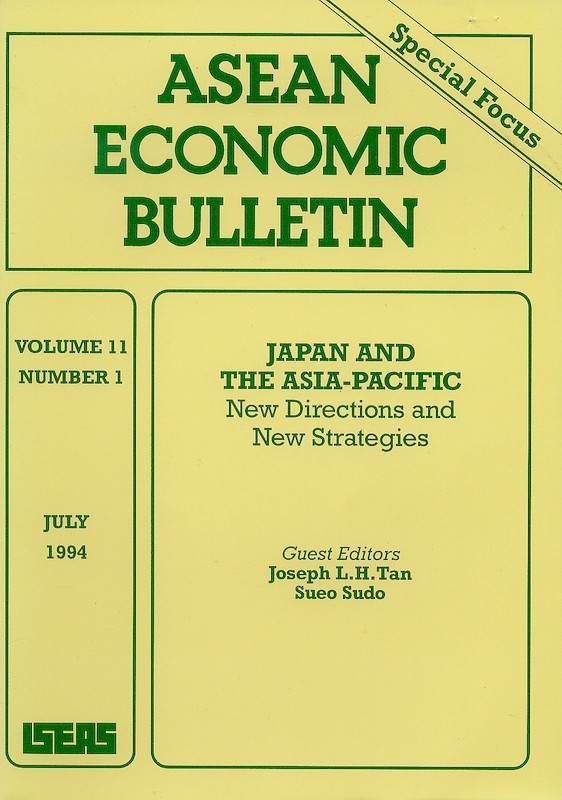ASEAN Economic Bulletin Vol. 8/1 (Jul 1991)

Date of publication:
July 1991
Number of pages:
123
Code:
AE8/1
Contents
-
Preliminary pages
- ARTICLES
-
The 1980s: Economic Revolution in Latin America, Continuing Development in Asia, by Rolf J Luders, author see abstractThe 1980s were, from an economic growth point of view, a lost decade for Latin America, while most countries in Asia continued to grow at relatively high rates. As a result, in Latin America an economic revolution is taking place. Markets are being liberalized, the economies are becoming more outward-looking, and fiscal discipline is stressed. The examples of some of the must successful Asian economies are not insignificant in this endeavour. This article explains the reasons for the adoption of past economic policies in Latin America and searches for factors which might predict the direction of change, highlighting the influence of the experience of the Asian economies in this process.
-
Regional Economic Co-operation in Southern Africa and Southeast Asia, by Robert L Curry, Jr., author see abstractA growing feeling among analysts of economic co-operation in the Southern hemisphere holds that trade-driven, common-market oriented, powerful secretariat-led sub-regional bodies have uniformly poor records of economic accomplishments. ASEAN and SADCC are among the few such bodies that eschew this three-fold foci and concentrate on enhancing production via a set of rather unique approaches. SADCC's basic approach is on attracting official development assistance (ODA) to improve infrastructure, and ASEAN's is on attracting direct foreign investment (DFI). SADCC has been successful in doing so, but it has not been able to deal with Southern Africa's grinding poverty. ASEAN has not been successful in attracting DFI due to its specific schemes, but DFI to the region has been substantial because of Southeast Asia's general progress.
-
Foreign Direct Investment Flows in East and Southeast Asia: Policy Issues, by Stephen Guisinger, author see abstractForeign direct investment has been growing rapidly in East and Southeast Asia. During the last decade, investors from the newly industrializing economies have begun to invest abroad. Japanese manufacturers have shifted substantial portions of their production offshore. The rapid rise and changing patterns of foreign direct investment in the region have raised tensions. This study examines the patterns of foreign direct investment and the policy issues they raise. A mini-lateral investment treaty is proposed as a means for reducing these tensions and resolving policy conflicts.
-
Globalization of SMEs Through Strategic Alliances: An Empirical Analysis of Investment Strategies of Canadian SMEs in the Asia-Pacific Countries, by Harbans L Dhingra, author see abstractThere are numerous conditions and motivations that either induce or force business firms including small and medium enterprises (SMEs) to globalize their operations. While addressing the question of what opportunities are available to SMEs to enhance the possibilities of internationalizing their business operations, this study examines various home country-specific, host country-specific, industry-specific, and small, firm size-specific "pull" and "push" oriented determinants of internationalization. It suggests that the strategic alliances of equity joint ventures and non-equity contractual arrangements with offshore partners provide the necessary framework through which SMEs can convert their unique firm-specific advantages into productive resources. Furthermore, based upon a mail survey of over 170 Canadian SMEs, the study examines the pattern of their strategic alliances in a selected set of 12 countries of the Pacific Rim.
-
Managing Thai Trade Policy to Better Access Developed Countries' Markets, by Suthiphand Chirathivat, author see abstractThe dynamics of change in the management systems of the world economy have become more important to the Thai economy. The study assesses the implications of world trade management on Thailand's international trade. Thailand in the 1980s faced more trade barriers than ever from different forms of protectionism especially from the United States, the European Community and Japan, her major trading partners. The commercial transactions that formerly were based on free trade are now being increasingly replaced by managed trade. Thailand has to explore relevant issues and to clearly define its trade strategies and policy options, based on different management system levels. Overall, its ability to adjust should be flexible enough to allow for the maintenance of international competitiveness as well as to strengthen Thailand's negotiation position in a new world economic management environment.
-
DOCUMENTATION: Japan and ASEAN: Seeking a Mature Partnership for the New Age. Policy Speech by Prime Minister Toshiki Kaifu, Singapore, 3 May 1991
-
DOCUMENTATION: Keynote Address by Mr Goh Chok Tong, Prime Minister of the Republic of Singapore at the 8th General Meeting of the Pacific Economic Cooperation Conference, Singapore, 20 May 1991
-
DOCUMENTATION: Speech by the Hon. Dato' Seri Rafidah Aziz, Minister of International Trade and Industry, Malaysia at the 8th General Meeting of the Pacific Economic Cooperation Conference, Singapore, 20 May 1991
-
DOCUMENTATION: United States Vice-President Dan Quayle's Address at the 8th Pacific Economic Cooperation Conference, Singapore, 22 May 1991
-
BOOK REVIEW: Social Market Economy: An Economic System for Developing Countries, edited by Winfried Jung, by Ian Seaton Thynne, author
-
BOOK REVIEW: Thailand: Development Planning in Turbulent Times, by George Abonyi and Bunyaraks Ninsananda, by Lim Chee Peng, Umphon Phanachet, authors
-
BOOK REVIEW: Unity and Diversity, Regional Economic Development in Indonesia since 1970, edited by Hal Hill, by John Walton, author
-
BOOK REVIEW: An Economic Framework of Singapore, by Toh Mun Heng and Linda Low, by Tan Lin Yeok, author
-
BOOK REVIEW: Behind the Myth: Business, Money & Power in South East Asia, by James Clad, by Sree Kumar, author
-
Conferences, Workshops and Seminars
-
ASEAN Chronology 1991
-
Some Recent Publications


